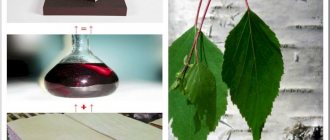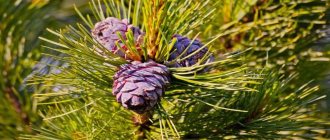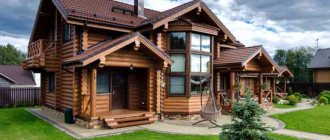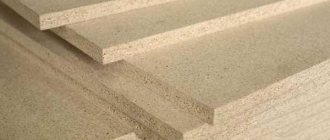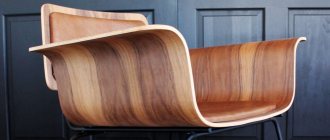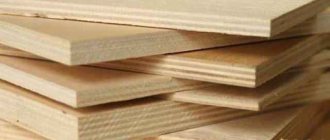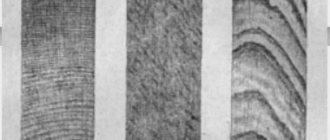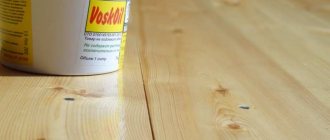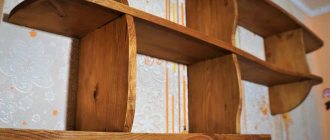Several thin wooden sheets securely glued together are a durable and beautiful finishing material for interior and exterior decoration called plywood. It has found wide application in various fields: in decorative works, creating strong and durable furniture, for high-quality packaging and in many other areas. To use this material correctly, you need to know what plywood is and what features it has.
Historical information about plywood
Archaeological excavations have proven that the creation of the first plywood sheets dates back to the 15th century BC. Their creation began in Ancient Egypt. Later, the masters of Ancient Greece and Rome began to use the veneering method.
Plywood was a material for the production of household items; furniture was made from it. Over time, the Romans expanded the use of individual thin wood slices, which were subsequently used to decorate various objects.
At that time, plywood was made by hand, using various compounds of natural origin as glue. It is worth noting that from those times to the present day, resins have been the basis of glue.
In the 18th century, the first machines appeared on which plywood was made, and in the twenties of the 20th century, the first standard plywood sheet format was released.
Standard plywood sheet sizes
Sheets can be divided by size into standard and large format. GOST regulates them as follows:
General Purpose Plywood Sheets
| Standard dimensions of sheets, mm | Large format plywood sheets, mm |
| 1220.00 to 1220.00 | 1830.00 to 1525.00 |
| 1525.00 to 1220.00 | 2440.00 to 1220.00 |
| 1525.00 to 1525.00 | 2500.00 to 1250.00 |
| 3000.00 to 1500.00 | |
| 3050.00 to 1525.00 |
Dimensions of laminated moisture-resistant plywood
Dimensions of waterproof sheets are based on the dimensions of plywood products for general use. For example, the size range of a well-known domestic product looks like this:
1) 1220/1250x2440/2500 mm;
2) 2440/2500x1220/1250 mm;
3) 1200/1500/1525x2500/2745/3000/3050 mm
Dimensions of the popular Finnish WISA plywood: 1220*2440 mm and 1250*2500 mm.
| sheet thickness, mm | 6,5 | 9 | 12 | 15 | 18 | 21 | 24 | 27 | 30 | >30 |
| number of veneer layers | 5 | 7 | 9 | 11 | 13 | 15 | 17 | 19 | 21 |
Bakelite plywood dimensions
Dimensions 5700 mm x 1250 mm or 2800 mm x 1250 mm. Sheet thickness ranges from 5 mm to 40 mm.
Like any other sheet material, plywood does not have ideal geometry. Errors occur during the cutting process. They are not so large as to be noticeable to the naked eye, but you need to know that they exist and that this is normal
This is especially important for furniture makers who cut parts from sheets to exact dimensions.
GOST 3916.1-96 regulates the maximum permissible geometric deviations in relation to the length and width of the plane. These data are shown in the table below.
Permissible geometric deviations
| Length/width of the plywood sheet plane, mm | Critical deviation, mm |
| 1200 | +/- 3,0 |
| 1220 | |
| 1250 | |
| 1500 | +/- 4,0 |
| 1525 | |
| 1800 | |
| 1830 | |
| 2100 | +/- 4,0 |
| 2135 | |
| 2440 | |
| 2500 | |
| 2700 | +/- 5,0 |
| 2745 | |
| 3050 | |
| 3600 | |
| 3660 |
There is also a permissible deviation in terms of thickness. It depends not only on the standard value, but also on the degree of processing of the planes. The pivot table looks like this:
| Standard thickness of plywood sheets, mm | Number of wood layers, not less | Critical deviation for sanded plywood, mm | Critical deviation for unsanded plywood, mm |
| 3,00 | 3 | from +0.30 to -0.40 | from +0.40 to -0.30 |
| 6,50 | 5 | from +0.40 to -0.50 | from +0.90 to -0.40 |
| 9,00 | 7 | from +0.40 to -0.60 | from +1.00 to -0.50 |
| 12,00 | 9 | from +0.50 to -0.70 | from +1.10 to -0.60 |
| 15,00 | 11 | from +0.60 to -0.80 | from +1.20 to -0.70 |
| 18,00 | 13 | from +0.70 to -0.90 | from +1.30 to -0.80 |
| 21,00 | 15 | from +0.80 to -1.00 | from +1.40 to -0.90 |
| 24,00 | 17 | from +0.90 to -1.10 | from +1.50 to -1.00 |
| 27,00 | 19 | +1.00 to -1.20 | from +1.60 to -1.10 |
| 30,00 | 21 | from +1.10 to -1.30 | from +1.70 to -1.20 |
The presence of deviations in the geometry of the sheet does not mean that it needs to be rejected. First, you should make sure that this run exceeds the tolerance allowed by the standards. And after this, plywood needs to look for another application that does not require maintaining strict geometric shapes.
Save the page to your browser bookmarks. It is impossible to do without size information when calculating the cost to estimate losses in the form of trimmings. In addition, there are logistical aspects. Before transportation, it is necessary to calculate how much space (what volume) the plywood will take up. Storage also involves calculating the capacity of the room.
This is interesting: How to choose a laminate based on quality - we study from all sides
Application area of plywood (TOP 8 areas)
Due to its functionality and reasonable price, plywood is used in many areas.
- In construction. This material is used for cladding various buildings. It is used at all stages of house construction, from formwork, floor formation and ending with the roof. The construction of scaffolding is also not complete without plywood, and in many other situations.
- In design decisions. Plywood sheets are an excellent material for facing various surfaces. Soundproofing panels, window sills, elevator trim, door trim - these and many other building details are made from this material.
- Furniture industry. Products produced by furniture factories quite often contain plywood sheets. Various accessories and decorative elements and designs for household items are manufactured.
- Plywood is used in almost all branches of transport construction. It is used due to the light weight of the material and excellent strength. To equip vehicles and make them convenient to use, plywood is used (walls, floors, sides, etc.).
- When organizing sports and play facilities, various types of plywood are also often used.
- In packaging production, plywood is used to make boxes and various packaging products.
- Objects found in everyday life. Advertising equipment and various semantic signs are made from waterproof types of plywood.
- In the decorative area. High-quality products are used to decorate spaces in houses and apartments. Decorative elements are created.
Taking into account the technical characteristics, plywood can be used in various fields of human activity.
FSF and FC plywood: similarities and differences
Both types of material have similar properties and a wide range of applications. Unlike FSF, a different type of glue is used in the production of FC - urea. This material is a glued veneer. FC plywood is distinguished by its versatility, which is due to the strength of the sheets. The material acquired this property due to the arrangement of the fibers - at an angle to each other, most often perpendicular. FC plywood is moisture resistant. Despite this, it is used mainly for interior decoration, for example, as a base for laminate or parquet. This is due to the absence of phenol in the composition. FC sheets refer to budget materials.
Important: After prolonged contact with moisture, FC plywood becomes deformed (flakes, curls), such changes occur during the drying process.
External differences between FSF and FC
The difference between FSF plywood and FC
At a quick inspection, the difference between the materials is invisible. However, upon careful examination of the external characteristics, you can see that the FSF sheets are darker in the cut areas. This can be explained by the type of additional components, in particular, the use of impregnation to increase the moisture resistance of the material. As a result, the layer is characterized by a barely noticeable red tint. FC sheets are lighter in cut.
INTERESTING: Plastic rings for wells: types, sizes and installation
Types of plywood
There are quite a large number of varieties of plywood.
What is moisture resistant plywood?
The uniqueness of this product lies in its composition, or rather in the special components that are used in its manufacture. They are responsible for reliable protection of plywood from moisture. Most often, large manufacturers impregnate the wood with drying oil or coat it with special varnish and paint. At the design stage, it is determined what degree of moisture resistance the product will have. The required parameters are set using connecting resins. An experienced specialist can easily determine, even by appearance, what level of moisture resistance a product has.
There are several main advantages of waterproof plywood. These include:
- High degree of moisture and water resistance. This suggests that the material does not tend to collapse under the influence of water. In addition, it will not come apart or lose shape;
- Easy processing. Although plywood is considered a fairly durable product, its processing is not difficult. Using ordinary tools and equipment, you can adjust the shape of the sheet and mount it on the required surface;
- Simultaneous use with other building materials. Waterproof plywood is often used as an additional covering. It easily combines with both natural components and polymers;
- High degree of wear resistance. Plywood is able to withstand strong mechanical stress while maintaining its integrity. It is this indicator that is responsible for the long service life of the product. Plywood can retain its appearance unchanged for a considerable time;
- Resistance to temperature changes. Thanks to this indicator, many people install waterproof plywood in the bathroom and toilet;
- Availability. Waterproof plywood is considered a budget coating and costs several times less than the same wood. There are both high-quality sheets and simpler ones.
Birch plywood
Its difference is in density (approximately 700 kg/m3). This figure is slightly higher than the density of softwood plywood. Today, birch plywood is quite popular among consumers because it has significant advantages over its analogues.
- Firstly, there are no difficulties with its creation. After all, birch is very common in our country.
- Secondly, birch veneer is a natural product, and therefore an environmentally friendly raw material for the production of plywood. The material is extremely beautiful, durable, and has an interesting natural pattern. In furniture production, birch plywood is used to make aesthetically interesting furniture.
- Thirdly, in addition to its strength, birch veneer plywood is characterized by good moisture resistance. This means that the service life of products made from this material is quite long.
- Fourthly, birch wood is malleable and responds remarkably to processing. Therefore, it is very convenient to work with her. At the same time, the use of all kinds of chemical additives is minimized.
For exterior decoration of premises, FSF birch plywood is often used. What kind of building material is this? Its production involves a specific adhesive composition - resin phenol formaldehyde. Since such plywood is resistant to damp conditions, it is used in exterior finishing work of buildings.
Birch plywood is represented on the building materials market in five grades. The basis for classification by grade is the condition of the outer coating, as well as the level of quality of sheet surface treatment. You can determine the grade by studying the list of permissible defects, according to GOST.
Divisions and nuances
FC plywood is divided into grades:
Table of plywood grades.
- 1st grade. Plywood with this grade marking has an ideal surface on which to apply varnish. At the same time, defects in the top veneer along the length should not exceed 20 cm, and such defects as chipped edges, lack of veneer on one side of the sheet should not be more than 3 in number. And if they are present, the dimensions should be minimal.
- 2 varieties. This FC plywood has a slightly larger number of defects and possible production damage. Cracks no larger than 20 cm in size and the presence of inserts from other wood are allowed. Defects in the outer veneer layer, such as scratches and dents, should be no more than 5% of the total area of the plywood sheet. At the same time, the wood itself, from which veneer for grade 2 plywood is produced, may have knots of different colors and holes associated with their loss as a result of processing in production.
- 3 varieties. On such plywood, defects in the amount of 9 pieces are allowed, such as knots (fused, healthy), wormholes with a diameter of 6 mm. During production, glue can leak onto the edges or joints of veneer sheets by 5% of the total sheet area. The width of the edge defect associated with the lack of veneer should not exceed 20 cm, as well as the overlap.
- 4 varieties. This is plywood of the lowest quality production. The number of knots, both fallen and present, is not limited. In addition, the standards do not impose restrictions on wormholes whose diameter does not exceed 40 mm. Due to such low quality of grade 4 plywood, it is used for the production of containers and other rough construction work.
Table of properties of FC plywood.
In addition to dividing into grades, FC plywood can be divided according to the degree of treatment of the outer surface into unsanded, sanded on one side, sanded on both sides. This division is indicated in the sheet marking with the designations НШ, Ш1, Ш2, respectively. A description of all the characteristics of plywood must be included in the documentation available from the seller of this product. The buyer has the right to demand it.
The thickness of the plywood sheet ranges from 3 mm to 30 mm. This characteristic is determined by the number of glued layers of veneer. When producing plywood, an odd number of veneer sheets are glued together. That is, if the sheet thickness is 3 mm, then 3 layers of veneer were glued together to make it. 30 mm plywood consists of 21 layers and is the most durable.
When gluing, the wood fibers of the combined veneer sheets are located at the same angle, which ensures strength.
Dependence of durability on stress during transverse bending for FK plywood of various laminations.
The wood species of the central layer of plywood, onto which the veneer is subsequently glued, may differ from each other. But this does not in any way affect the characteristics of the plywood as a whole. If more than 2 sheets are used in the production of plywood, and their wood fibers are at right angles to each other, then the result will be facing plywood.
Most often, birch wood is used as a starting material for the production of FC plywood.
However, the use of coniferous species is acceptable. Plywood made from birch or pine can be distinguished by eye by the texture and color of the outer veneer.
Softwood plywood
GOST 3916.2-96 is the basis for the production of plywood from coniferous trees. According to this document, such plywood is divided into grades, grades and types (homogeneous and combined type).
The produced material is lightweight with solid strength. Most often, attractive pine wood is used in production.
The advantages of coniferous plywood can be used in the construction of housing and furniture production. Plywood, as a material, is present in interiors and exteriors.
Plywood grades depending on water resistance
FK grade plywood - gluing is done with urea resin. Designed for indoor use.
Plywood brand FSF (increased moisture resistance) - layers are glued together with phenolic resin. Can be used both indoors and outdoors.
FB grade plywood (bakelized plywood) - glued together after impregnation with bakelite varnish. Can be used in tropical climates, sea water and other types of aggressive environments.
FOF plywood (laminated plywood) is birch plywood lined on one or both sides with a film coating (paper impregnated with synthetic resin).
Laminated plywood
Distinctive features of this type are:
- High level of moisture resistance;
- The use of adhesives with increased moisture resistance;
- Made from various types of wood;
- Resistance to natural and chemical environmental conditions;
- It is coated with a film made from carefully tarred paper;
- Has excellent density.
These parameters of laminated plywood give it the right to prevail in various industries and construction.
Advantages of laminated plywood:
- Quite a long service life due to high wear resistance.
- Reasonable price for buyers of various levels.
- High quality.
- Simple, convenient installation.
- Attractive, aesthetic appearance.
- Harmlessness.
- Wide range of choice.
When choosing plywood, you need to decide for what purpose it is being purchased. Only after this, pay attention to parameters such as:
- Thickness of plywood sheets.
- Their sizes.
- Moisture resistance level.
- Safety and environmental friendliness of the material.
- Type and quality of sheet surface treatment.
- Variety
- Product brand.
- Price-quality ratio.
All information about this building material can be obtained from both sales consultants and highly qualified specialists.
Varieties according to GOST
FSF plywood is distinguished according to the composition used for impregnation. In this case, the product can be:
Moisture resistant
Waterproof (GOST 3916.1 96). Plywood, which has lower water resistance, can be used in the production of furniture, interior cladding of rooms, and in the production of wooden utensils.
Laminated
Laminated (GOST 21 1500 3000) is a material for which a special method is used for impregnation. Thanks to this, it is possible to increase resistance to moisture. To maximize moisture resistance, lamination is used.
Bakelite moisture-resistant plywood 2440x1220x20 and other features of the building material can be read here from the article.
Berezovaya
Birch is a material produced by gluing thin layers of peeled veneer. For gluing, phenol-formaldehyde resins with emission class E1 are used here. Thanks to a special glue, it is possible to increase resistance to moisture, and, therefore, plywood can be used when finishing rooms with high levels of humidity. The material is characterized by excellent ability to withstand heavy loads. FChF birch plywood is lightweight and easy to install. It is also very easy to process.
Fsf and fk plywood, the differences and other features of the building material are indicated in this article.
